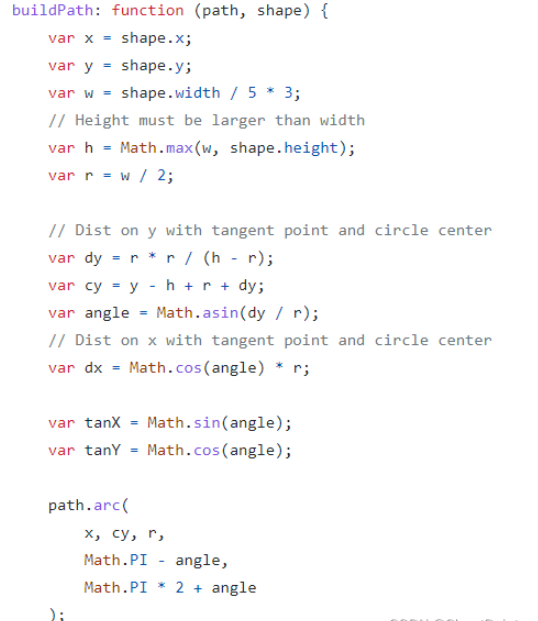Echarts怎么自定义图形
导读:本文共3646字符,通常情况下阅读需要12分钟。同时您也可以点击右侧朗读,来听本文内容。按键盘←(左) →(右) 方向键可以翻页。
摘要: 1.自定义图形最后的效果是这样的:图形由三个面组成,需要定义三个形状。用cubeleft,cubetop,cuberight来分别定义左侧面,顶部面以及右侧面。2.注册自定义的图形echarts官方文档处:Documentation - Apache ECharts我们需要定义一个这样的类,然后再通过echarts来注册这个类,后续就可以通过类名来使用了。3.e... ...
目录
(为您整理了一些要点),点击可以直达。1.自定义图形最后的效果是这样的:

图形由三个面组成,需要定义三个形状。用cubeleft,cubetop,cuberight来分别定义左侧面,顶部面以及右侧面。
2.注册自定义的图形
echarts官方文档处:Documentation - Apache ECharts

我们需要定义一个这样的类,然后再通过echarts来注册这个类,后续就可以通过类名来使用了。
3.extendShape
//绘制左侧面constCubeLeft=echarts.graphic.extendShape({shape:{x:0,y:0},buildPath:function(ctx,shape){constxAxisPoint=shape.xAxisPointconstc0=[shape.x,shape.y]constc1=[shape.x-13,shape.y-13]constc2=[xAxisPoint[0]-13,xAxisPoint[1]-13]constc3=[xAxisPoint[0],xAxisPoint[1]]ctx.moveTo(c0[0],c0[1]).lineTo(c1[0],c1[1]).lineTo(c2[0],c2[1]).lineTo(c3[0],c3[1]).closePath()}})//绘制右侧面constCubeRight=echarts.graphic.extendShape({shape:{x:0,y:0},buildPath:function(ctx,shape){constxAxisPoint=shape.xAxisPointconstc1=[shape.x,shape.y]constc2=[xAxisPoint[0],xAxisPoint[1]]constc3=[xAxisPoint[0]+18,xAxisPoint[1]-9]constc4=[shape.x+18,shape.y-9]ctx.moveTo(c1[0],c1[1]).lineTo(c2[0],c2[1]).lineTo(c3[0],c3[1]).lineTo(c4[0],c4[1]).closePath()}})//绘制顶面constCubeTop=echarts.graphic.extendShape({shape:{x:0,y:0},buildPath:function(ctx,shape){constc1=[shape.x,shape.y]constc2=[shape.x+18,shape.y-9]constc3=[shape.x+5,shape.y-22]constc4=[shape.x-13,shape.y-13]ctx.moveTo(c1[0],c1[1]).lineTo(c2[0],c2[1]).lineTo(c3[0],c3[1]).lineTo(c4[0],c4[1]).closePath()}})这段代码主要是看buildpath如何使用,zrender的官方文档中,并没有直接告诉这个方法的两个参数是干什么用的,只给了一个示例,从这个示例中,可以知道这两个参数具体怎么用。

第一个参数是path,第二参数是shape。path可以理解为一个canvas中的绘制画笔,可以设置路径并且闭合路径。
第二个参数在echarts中,是自定义的custom传递过来的,因此可以通过这个对象获取到我们一个很熟悉的属性 xAxisPoint。
绘制的两个面中,只有左侧和右侧面需要有填充高度,顶部不需要,所以顶部的形状就没有使用xAxisPoint这个属性。
这也是很好理解的,因为我们自定义的伪圆柱体里面的填充物肯定是有一个高度的。填充多少根据我们的数据来知道,让它看起来确实是被某种东西从底部开始增多填充了。
拿比较简单的顶部来举例:
buildPath:function(ctx,shape){constc1=[shape.x,shape.y]constc2=[shape.x+18,shape.y-9]constc3=[shape.x+5,shape.y-22]constc4=[shape.x-13,shape.y-13]ctx.moveTo(c1[0],c1[1]).lineTo(c2[0],c2[1]).lineTo(c3[0],c3[1]).lineTo(c4[0],c4[1]).closePath()}绘制的四边形,其实就是四个顶点,我们只需要用moveTo来控制路径就行,在最后那个点进行闭合就行。偏移量是固定的值,可以根据情况自己去设置不同的值来扭曲这个四边形。
其中c1是底部的顶点,c2是右侧的顶点,c3是顶部的顶点,c4是右侧的顶点。其他两个面也是类似的。
4.使用echarts注册这三个图形
//注册三个面图形echarts.graphic.registerShape('CubeLeft',CubeLeft)echarts.graphic.registerShape('CubeRight',CubeRight)echarts.graphic.registerShape('CubeTop',CubeTop)5.使用自定义的形状
其他的数据都和正常使用echarts一样,不同的地方在于series的配置。
series数组中,总共放置二个对象。第一个对象如下:
{type:'custom',renderItem:function(params,api){constlocation=api.coord([api.value(0),api.value(1)])return{type:'group',children:[{type:'CubeLeft',shape:{api,x:location[0],y:location[1],xAxisPoint:api.coord([api.value(0),0])},style:{fill:'rgba(47,102,192,.27)',stroke:'black'},z2:999},{type:'CubeRight',shape:{api,x:location[0],y:location[1],xAxisPoint:api.coord([api.value(0),0])},style:{fill:'rgba(59,128,226,.27)',stroke:'black'},z2:999},{type:'CubeTop',shape:{api,x:location[0],y:location[1],xAxisPoint:api.coord([api.value(0),0])},style:{fill:'rgba(72,156,221,.27)',stroke:'black'},z2:999}]}},data:MAX}最主要的还是renderItem里面的逻辑,这个方法返回一个对象,对象就是我们自定义的一个group组。renderItem可以返回的对象在文档中都有说明:Documentation - Apache ECharts
我们定义的那三个面,需要把它看成一个整体,所以renderItem返回的是一个类型为group的对象,另外三个形状作为children保存在数组中。
其中的shape参数,会在buildpath中使用到。
style中设置了它的填充颜色和边框线颜色。然后使用z2定义这个echarts的显示层级为最上级。如果不使用它,下面用于填充的会将其遮挡住。
这里也只是定义了第一个自定义的形状,也就是最外层的那个伪3d柱体。第二个自定义形状是要填充的形状。
{type:'custom',renderItem:(params,api)=>{constlocation=api.coord([api.value(0),api.value(1)])varcolor=newecharts.graphic.LinearGradient(0,0,0,1,[{offset:1,color:"#FEFD53"},{offset:0,color:"#f7c824"}]);return{type:'group',children:[{type:'CubeLeft',shape:{api,xValue:api.value(0),yValue:api.value(1),x:location[0],y:location[1],xAxisPoint:api.coord([api.value(0),0])},style:{fill:color,stroke:'red'}},{type:'CubeRight',shape:{api,xValue:api.value(0),yValue:api.value(1),x:location[0],y:location[1],xAxisPoint:api.coord([api.value(0),0])},style:{fill:color,stroke:'red'}},{type:'CubeTop',shape:{api,xValue:api.value(0),yValue:api.value(1),x:location[0],y:location[1],xAxisPoint:api.coord([api.value(0),0])},style:{fill:color,stroke:'red'}}]}},data:VALUE}内部填充的图形,使用了一个线性渐变的颜色用来填充。边框线使用红色。与第一个不同的是,style里面的风格,以及data使用的数据。这里的data使用value具体的数值。而外壳的图形使用的数据是max最大值。这样就会有一个渐变颜色填充的红色边框图形,填充到了一个黑色边框的柱体中。这样就自定义好了一个视觉上的3d柱体形状的图表了。
</div> <div class="zixun-tj-product adv-bottom"></div> </div> </div> <div class="prve-next-news">Echarts怎么自定义图形的详细内容,希望对您有所帮助,信息来源于网络。